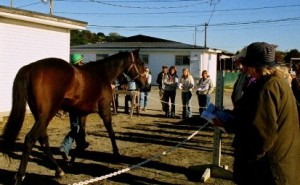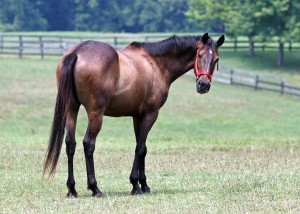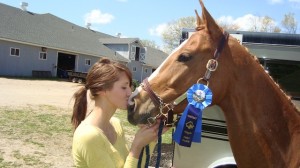The 7th annual CANTER New England Suffolk Showcase takes place on the backside of the East Boston racetrack this Sunday, beginning at 8:30 a.m.
Approximately 80 Thoroughbreds, who are available for purchase, will be walked and trotted before a crowd of prospective buyers. All are welcome. Those with questions about the event itself are invited to read CANTER New England’s blog.
In honor of the annual Thoroughbred-buying event, OffTrackThoroughbreds.com offers this excerpted interview with Dr. Laurie Metcalfe, DVM associate, Rood & Riddle Equine Hospital. She offers insights on what to consider when purchasing an OTTB.
Q: What do you consider to be the most important tests in a pre-purchase veterinary exam and why?
Number one for me is a complete, thorough physical exam.
I feel it is the most undervalued diagnostic tool available to us as veterinarians and can be loaded with valuable information.
Everyone is always extremely concerned with the lameness exams and flexion tests.
While very important, it may not matter where the horse is sore if it has a heart condition limiting exercise or a recurrent airway obstruction (“heaves”) preventing him from ever taking a deep breath.
The PPE must look at the whole horse— I have been told that you don’t ever miss things because you don’t know; you miss them because you didn’t look. I try to remember this during my physical examinations.
Also important while performing a physical exam is that it provides an opportunity to judge a horse’s personality, behavior, and how they are responding to me. If it takes me 10 minutes to get a look at the teeth, chances are you may have trouble getting a bit easily into that mouth.
No one will care about his lameness if you can’t get any tack on.
Q: Can you offer any pointers for judging a jog or watching a horse walk in hand?
I always tell people to use all of their senses: look and listen.
Watch the head for obvious things like a “head-bob.” The expression, “down on the sound,” is a phrase many people use.
A horse’s head is extremely heavy. When they are sore on one limb or another, they attempt to take this weight off of the affected limb to ease the load. As a result, when this limb is weight bearing in front, the head will go up.
When the good limb is weight bearing, the head will go down.
It sounds obvious, but concentration is required to determine which leg is sore, especially when this can be very subtle.
In addition, use your ears as well as your eyes. Horses will land harder and louder on a sound limb than a sore one, which especially helpful when they are shod. Also watch their ears and facial expression— if they are uncomfortable or in pain, many horses will demonstrate this in their body language.
Q: What are some best practices for letting down a racehorse once he or she moves to a new home?
One of the most important things is establishing a routine.
All creatures crave routine, even without realizing it, and it is particularly important with these animals early on.
Their day was undoubtedly like clockwork at the racetrack and it is what most are accustomed to.
Horses should be fed at the same time daily, turned out in the same paddock, and live in the same stall.
I often tell people to back off the high-concentrate feeds to start. They don’t have the same high-energy demands like they did racing and therefore will not require as many calories.
Get a buddy for them if they’re amenable to it, either another horse, a donkey, even a goat! Many horses adjust better with a companion.
Make sure the horse is thoroughly examined by a veterinarian prior to any turnout to ensure there are not injuries requiring stall rest.
If healthy, being turned out to “just be a horse” for a while will help many settle down, however their personality and behavior must dictate this decision.
When all else fails, some horses do well with a 30-day tranquilizer to ease the transition, but as with all drugs there are potential side effects, so ideally they can do this drug-free.
Q: If an ex-racehorse doesn’t gain weight, or exhibits other signs he or she is failing to thrive, what are some of the options the owner should consider?
As a veterinarian, I would start by ruling out any physiological issues.
Poorly maintained teeth are a frequent cause of weight loss. Have the horse’s teeth checked for sharp points, oral ulcers or other dentition problems.
Many of these horses arrive with no history, and some will have never experienced a float, so this can significantly affect how they utilize their food. Other physical issues include gastric ulcers. Horses affected by ulcers don’t necessarily appear “stressed.”
Having your veterinarian use an endoscope to look in the stomach is a definitive diagnosis, however frequently cost prohibitive.
Many people choose to just treat these horses with anti-ulcer medication such as omeprazole (gastrogard/ulcergard) or ranitidine (zantac) and have positive results.
Heart conditions can also affect weight gain as well as a large parasite burden. With any failure to thrive case, I would have your horse thoroughly examined by your veterinarian and include blood work and a fecal analysis. If the horse checks out physically, there could be environmental changes required, such as improving inadequate pasture or feed quality. Each case is individual, and should be treated accordingly.
Q: What is the biggest success story you can cite of a racehorse or ex-racehorse?
The biggest success story for me is very personal, in that it is my own 30-year-old gelding, “Cool Under Fire” AKA “Elliot.”
Elliot (known as Sportin Aron in his racing days) was an utter failure as a racehorse, starting over 10 times in three or four years, retiring with no wins and best place finish being second to last in one glorious start.
He retired from racing and quickly climbed to the top of the horse show world, showing, and winning, at AA level in Large Jr. Hunter and Owner/Hunter divisions.
He showed under three different owners everywhere from Palm Beach to Lake Placid to the Capital Challenge and did everything ever asked of him. Elliot showed up until 2002 and was retired at the age of 22.
Eventually, he was donated to the Thoroughbred Retirement Foundation at Blackburn Correctional facility here in Lexington, where his personality quickly made him a favorite among the inmates.
I first met El as an intern, when I frequently treated him for choke (he has an esophageal stricture) and allergies (constantly breaking out in hives).
Naturally, I too adored him and, knowing that due to his age and high maintenance veterinary issues he was lower on the adoptability list, he came home with me.






